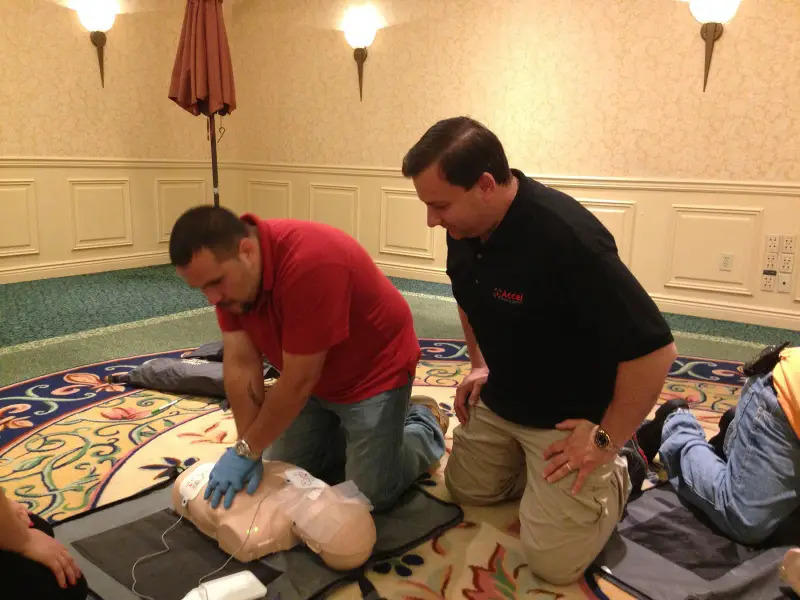Jason Goldberg, owner of the Westhcester-based Accel Health & Safety and an American Safety & Health Institute instructor, shares the differences between heart attack and sudden cardiac arrest, as well as how to help someone having a heart attack or going into sudden cardiac arrest.
 Courtesy Jason Goldberg |
| Franco Sagni practices CPR and using an AED under the guidance of Accel Health & Safety Instructor Trainer Jason Goldberg. |
What’s the difference between sudden cardiac arrest and a heart attack?
Sudden cardiac arrest is when the heart either completely stops or is in a rhythm that is ineffective to sustain life. A heart attack is some pain or discomfort caused by a blockage where the heart is not functioning properly but life is still sustained by the decreased output of the heart.
Now a heart attack could lead to sudden cardiac arrest, so it’s important to identify the onset symptoms of a heart attack, which are varied. Then help the person having a heart attack by activating EMS (emergency medical services) and prepare to administer CPR and use an AED (automated external defibrillator) if sudden cardiac arrest occurs.
Symptoms of a heart attack are very interesting because they differ between men and women. Men might experience what’s called the “elephant on the chest” syndrome—it feels like you have an elephant sitting on your chest—they might have trouble breathing or pain down the left arm. Women experience all of those same things, but as studies have shown, there are additional symptoms women might experience that are what we call more “delicate,” which are back pain and jaw pain almost like a toothache.
What can I do to help somebody who is either having a heart attack or going into sudden cardiac arrest?
The number one thing is to activate EMS. There’s something called the cycle of survival, which is early recognition and activation of EMS, early CPR, early AED, and then advanced medical care. What you want to do in a heart attack is recognize the situation, activate EMS, and care for that person by making them comfortable and removing restrictive clothing.
You can encourage that person—I want to be very specific and very clear here that laypersons are not permitted to administer, but can assist somebody in taking, medication—to chew a baby aspirin.
If somebody has a history of heart attack and they happen to carry nitroglycerin then the number one thing that you can do is make them comfortable and adjust restrictive clothing, activate the EMS, and prepare for sudden cardiac arrest.
When someone goes into sudden cardiac arrest, you’re taught during a CPR class how to recognize that. Check for normal breathing—not slow sips of air where somebody might be making just tiny little breath sounds. After that, students learn how to administer cycles of chest compressions and rescue breaths and then immediately as fast as you possibly can, get an automated external defibrillator on-site.
An AED is a really smart device. You put electrodes on the person who has gone into sudden cardiac arrest. Once you apply the electrodes, the machine begins reading the electrical rhythm of the heart, and if it can shock the heart into a normal rhythm, it will attempt to do so. It’s automated because you don’t have to be a physician or a paramedic to know how to read an AED—most don’t even have screens on them. It’s the simplest device to use. It talks you through every step of CPR and using the AED, and once you hit the power button it literally tells you when to apply the pads, when a shock is needed, and when to continue performing CPR.
Is sudden cardiac arrest the main reason to use CPR or are there others?
Sudden cardiac arrest is one reason to administer CPR. Remember CPR is cardiopulmonary resuscitation, so you could use CPR if somebody may not be breathing but his or her heart might be beating. Examples are if somebody was in a drowning incident or somebody went into anaphylactic shock—they had an allergic reaction to something—they may not be breathing but their heart might be beating. In CPR class, students learn to perform CPR in those cases as well. So depending on the CPR class they take, they’ll learn to perform simply rescuing on their own or go through the cycle of compressions and rescue breaths. As long as somebody isn’t breathing you make the assumption that the heart is not beating.
Jason Goldberg is the owner of Accel Health & Safety, which offers CPR and first aid courses for laypersons and professionals. Goldberg is an American Safety & Health Institute instructor Trainer, Emergency First Response instructor, a National Academy of Scuba Educators instructor, and a Professional Association of Diving Instructors professional. For more information, visit accelcpr.com.





















